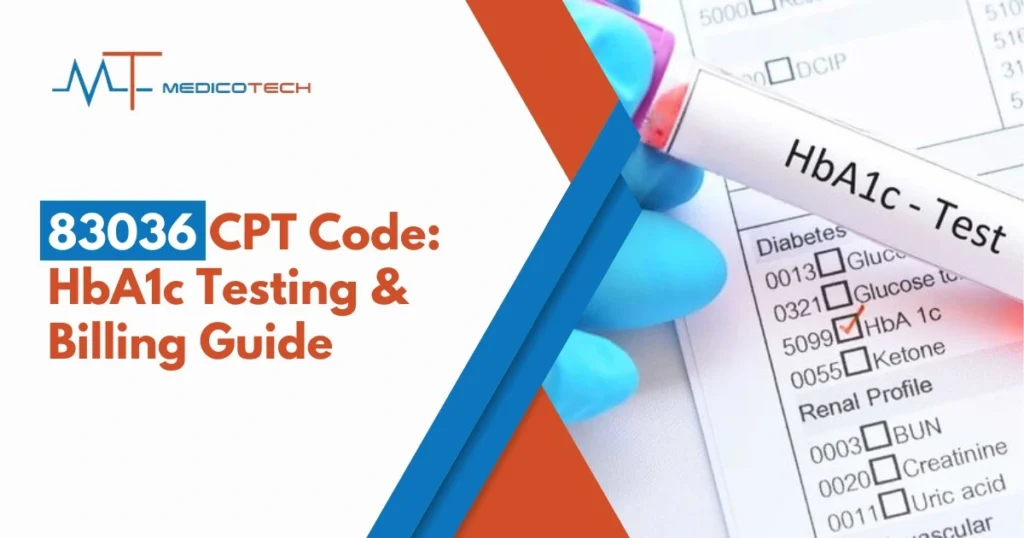83036 is a CPT code predominantly used in the healthcare segment to perform an HbA1c test that is one of the most effective tools in the diagnosis and treatment of diabetes. This article contains a detailed overview of CPT 83036 since it explains what it is, how it should be billed, what is considered to be medically necessary, the reimbursement from it, and some typical problems it can have concerning denials and governance. It is formulated to guide medical practitioners to know about the intricacies of this code so that they are able to do the correct billing and reimbursement.
What is CPT Code 83036?
Definition: Glycated Hemoglobin (HbA1c) Test
CPT 83036 refers to the Glycated Hemoglobin (HbA1c) test, a blood test used to measure a person’s average blood sugar (glucose) levels over the past two to three months. The test assesses how much glucose is bound to hemoglobin, the protein in red blood cells that carries oxygen. This test is an essential tool in diagnosing and monitoring diabetes, especially in controlling long-term blood sugar levels.
Clinical Purpose: Diabetes Diagnosis & Monitoring
The primary clinical purpose of the HbA1c test is to assist in the diagnosis, treatment, and monitoring of diabetes. The test provides a reliable long-term picture of blood glucose control, unlike random glucose or fasting blood sugar tests, which only provide a snapshot of the current state. The HbA1c test is used to:
- Diagnose Type 1 and Type 2 diabetes.
- Monitor the effectiveness of diabetes treatments.
- Assess risk for diabetes-related complications (e.g., heart disease, nerve damage).
- Identify prediabetes and poor glycemic control in diabetic patients.
CPT 83036 vs. 83037: Lab vs. Point-of-Care Testing
While CPT 83036 refers to laboratory-based HbA1c testing, CPT 83037 covers point-of-care (POC) testing for HbA1c. Here’s a quick comparison of the two:
- CPT 83036: Performed in a clinical or hospital laboratory, providing a more accurate and controlled testing environment.
- CPT 83037: Performed at the point of care, such as a physician’s office, and provides immediate results for patient management during the same visit.
CPT 83036 Billing Guidelines
Modifiers: QW (CLIA-Waived), 91 (Repeat Test)
When billing for CPT 83036, certain modifiers may be required based on the testing conditions:
- QW: This modifier is used when the test is performed with a CLIA-waived device, which is authorized for use in non-laboratory settings such as physician’s offices.
- 91: Used for repeat testing when an HbA1c test is ordered multiple times on the same day for the same patient.
Place of Service (POS) Codes: Lab (81) vs. Office (11)
Correct coding of the Place of Service (POS) is crucial to determine the setting where the test was performed:
- POS 81: For lab settings, typically in hospitals or commercial laboratories.
- POS 11: For tests performed in an office setting, like a physician’s office or clinic.
Frequency Limits: Medicare (2-4 Tests/Year) & Payer Rules
Medicare and other insurers place restrictions on the frequency of testing. Generally, Medicare allows for 2-4 HbA1c tests per year, depending on the patient’s diagnosis. Testing may be allowed more frequently for individuals with uncontrolled diabetes or other medical conditions. Providers should verify the frequency limits with each payer to ensure compliance.
Ordering Requirements: Physician Authorization & Medical Necessity
A physician’s order is required for the HbA1c test, and it must be medically necessary for the patient’s condition. Proper documentation is essential to ensure reimbursement and avoid denials. The physician must indicate the reason for the test, such as:
- Monitoring diabetes treatment.
- Assessing risk for complications.
- Screening for prediabetes.
Medical Necessity & ICD-10 Codes
Valid ICD-10 Codes for HbA1c (2025)
In 2025, the correct ICD-10 codes must be linked to CPT 83036 to demonstrate medical necessity and justify the test. Below are the most commonly used ICD-10 codes related to HbA1c testing:
Diabetes Management: E11.65, E13.65
These codes are for Type 2 and Type 1 diabetes, respectively, with complications such as diabetic neuropathy or nephropathy. They are often linked to HbA1c tests for monitoring long-term blood sugar control.
Prediabetes Screening: R73.09
This code is used for patients who are at risk of developing diabetes but have not yet been diagnosed with the disease.
Gestational Diabetes: O24.4-
This category of codes is used for diagnosing and managing gestational diabetes that develops during pregnancy.
Avoiding Denials: Linking ICD-10 to CPT 83036
Accurately linking ICD-10 codes to CPT 83036 is essential to avoid denials. Common issues leading to denials include mismatched or missing ICD-10 codes. Ensure that the ICD-10 code reflects the medical reason for ordering the HbA1c test, such as managing diabetes or screening for prediabetes.
Coverage Policies
Medicare (NCD 190.21 & LCDs)
Coverage Limits: Asymptomatic vs. Diagnosed Diabetes
Medicare’s National Coverage Determination (NCD) 190.21 and Local Coverage Determinations (LCDs) define the coverage limits for HbA1c testing. These limits differentiate between asymptomatic and diagnosed diabetes, as the frequency of allowable tests may vary depending on whether the patient is newly diagnosed or already receiving treatment for diabetes.
Documentation Requirements
Medicare requires that providers submit proper documentation of the patient’s medical condition to justify the HbA1c test. This includes demonstrating the medical necessity for the test, such as the patient’s diabetes treatment plan or the risk factors for prediabetes.
Medicaid & Private Payers
UHC, BCBS, & Aetna Policies
Private payers like United Healthcare (UHC), Blue Cross Blue Shield (BCBS), and Aetna have their own policies regarding HbA1c testing. Coverage varies depending on the patient’s medical history, risk factors, and the payer’s specific guidelines. Always check each payer’s policies to ensure compliance.
Prior Authorization Rules
Some Medicaid and commercial payers require prior authorization for HbA1c testing, particularly if the patient is undergoing frequent testing or if the test is being performed as part of a broader diagnostic or monitoring procedure.
Audit-Proof Documentation: Key Elements
Audit-proof documentation is essential to ensure that claims for CPT Code 83036 are not denied, delayed, or underpaid. Proper documentation supports the medical necessity of the test and facilitates compliance with payer rules. The key elements to include are:
- Physician’s Order: A signed order from a physician or healthcare provider specifying the need for the HbA1c test.
- Medical Necessity: Detailed documentation of the patient’s medical condition that justifies the test. This could include diabetes management, prediabetes screening, or gestational diabetes.
- Patient History: Documentation of the patient’s diabetes diagnosis, previous HbA1c results, or risk factors, such as family history or lifestyle.
- Test Results: Include any prior HbA1c results, especially if the current test is being used for monitoring purposes.
- Treatment Plan: Any treatment protocols, including medications or lifestyle changes, that require monitoring via the HbA1c test.
Maintaining a complete and accurate medical record that includes these elements will make it easier to respond to payer inquiries and audits, ensuring the test is covered.
Lab-Specific Guidance
Quest Diagnostics & LabCorp Protocols
Both Quest Diagnostics and LabCorp, two of the largest laboratory service providers in the U.S., have specific protocols for performing and processing HbA1c tests. These protocols ensure consistency and accuracy in test results.
- Quality Control: These labs maintain strict adherence to quality control standards to ensure accurate HbA1c results.
- Patient Identification: Proper patient identification is critical to prevent mix-ups or errors in lab results.
- Turnaround Time: Laboratories typically provide HbA1c results within 24–48 hours, depending on the type of test.
Providers should familiarize themselves with the guidelines of labs they work with to ensure compliance with protocol and ensure accurate, timely results.
CLIA Waiver Requirements for In-Office Testing
For in-office testing, healthcare providers must comply with CLIA (Clinical Laboratory Improvement Amendments) waiver requirements. These requirements ensure that the in-office test meets quality standards and provides accurate, reliable results.
- Waiver Requirements: Only approved tests that meet FDA criteria for point-of-care use are eligible for a CLIA waiver.
- Proper Training: Providers must be trained in performing the test to ensure it meets accuracy and safety standards.
- Documentation: Testing must be properly documented to show compliance with CLIA regulations.
A CLIA waiver is crucial for reimbursing services under CPT 83036 when performed in a physician’s office or other non-laboratory settings.
Handling Specimens: Collection & Processing
Proper specimen collection and processing are essential for accurate HbA1c test results. Blood samples should be collected and processed according to specific guidelines to avoid invalid results.
- Collection: The blood sample is typically collected via venipuncture or a fingerstick (for POC testing).
- Handling: Blood samples must be kept stable and processed promptly to avoid hemolysis or degradation of the sample, which could affect test accuracy.
- Transportation: If the sample is to be transported to a central lab, it should be stored in an appropriate container and at the correct temperature to preserve integrity.
Proper handling of specimens ensures that results are reliable and reduces the risk of retesting, which can delay treatment.
2025 Updates & Best Practices
CMS Policy Changes (NCD 190.21)
The Centers for Medicare & Medicaid Services (CMS) periodically updates its National Coverage Determination (NCD) policies. In 2025, CMS made revisions to NCD 190.21, which covers the frequency and eligibility criteria for HbA1c testing. Key updates include:
- Increased Frequency: In certain cases, CMS has allowed for more frequent testing in patients with poor glycemic control or those undergoing active treatment for diabetes.
- Expanded Eligibility: CMS expanded coverage to include more categories of diabetic patients, such as those with newly diagnosed diabetes who require more frequent monitoring.
Healthcare providers should monitor CMS updates to stay informed about policy changes that affect reimbursement for HbA1c testing.
New ICD-10 Codes Impacting HbA1c
The introduction of new ICD-10 codes in 2025 affects how healthcare providers link diagnoses to HbA1c testing. New codes that may impact the use of CPT 83036 include:
- E11.9: Type 2 diabetes mellitus without complications (for diagnosis and monitoring).
- R73.01: Impaired fasting glucose (for prediabetes screenings).
- O24.41: Gestational diabetes mellitus, in the first trimester.
Using the most accurate and up-to-date ICD-10 codes ensures proper billing and increases the chances of reimbursement.
Pro Tips to Maximize Reimbursement
To ensure the highest reimbursement rates for CPT 83036, providers can follow these best practices:
- Accurate ICD-10 Coding: Use the most specific and up-to-date ICD-10 codes that match the patient’s condition to avoid denials.
- Use the Right Modifiers: Include modifiers like QW for CLIA-waived tests or 91 for repeat tests to indicate the test circumstances accurately.
- Ensure Medical Necessity: Always document the medical necessity of the test. Ensure that it’s clear why the test is needed, whether for diagnosis, monitoring, or screening.
- Stay Updated on Payer Policies: Each payer may have specific rules for coverage and reimbursement. Regularly review payer-specific policies to avoid surprises.
FAQs: CPT 83036
“Can I bill 83036 with 99213?”
Yes, CPT 83036 can be billed along with CPT 99213 (an office visit code), provided that both services are medically necessary. Ensure that the documentation for both the office visit and the HbA1c test clearly reflects the medical need for both services.
“Does Medicare cover HbA1c for prediabetes?”
Yes, Medicare covers HbA1c testing for prediabetes, as long as the test is medically necessary. The appropriate ICD-10 code for prediabetes (e.g., R73.09) should be used to link the test to the patient’s condition.
“What modifier is required for CLIA-waived devices?”
For CLIA-waived tests, the QW modifier is required to indicate that the test was performed using an approved, CLIA-waived device, typically in a non-laboratory setting like a physician’s office.
Resources & References
- CMS: National Coverage Determinations (NCD) 190.21 – Overview of Medicare coverage for diagnostic tests.
- AAPC: Resources for medical coding and compliance guidelines.
- AMA Guidelines: Updates and explanations of CPT code changes.
- Payer-Specific Policy Documents: Insurance company policies (e.g., UHC, BCBS, Aetna) for HbA1c testing reimbursement.




